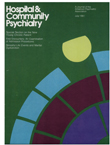The Young Adult Chronic Patient: Overview of a Population
Abstract
A new generation of persistently dysfunctional young adults (aged 18 to 35) has emerged in the community, requiring new programs in community care. This population, which includes a wide range of diagnostic groups, is under study at a suburban New York community mental health center. The center and county are serving 294 such young patients through a variety of programs which include a crisis service, a sheltered workshop, a residential program called the Community Link-Up Experience, an acute day treatment program, an alcohol day treatment program, a case management program, and a Growth Advancement Program that gives patients an opportunity to socialize and share problems with others their age. Residential programs that provide a supportive living situation to young adult chronic patients on both a temporary and a long-term basis are sorely needed and will require an increased outlay of funds. A case study of one young patient who visited the center sporadically over a 12-year period illustrates the treatment problems such patients pose. New York University School of Medicine in New York City
Access content
To read the fulltext, please use one of the options below to sign in or purchase access.- Personal login
- Institutional Login
- Sign in via OpenAthens
- Register for access
-
Please login/register if you wish to pair your device and check access availability.
Not a subscriber?
PsychiatryOnline subscription options offer access to the DSM-5 library, books, journals, CME, and patient resources. This all-in-one virtual library provides psychiatrists and mental health professionals with key resources for diagnosis, treatment, research, and professional development.
Need more help? PsychiatryOnline Customer Service may be reached by emailing [email protected] or by calling 800-368-5777 (in the U.S.) or 703-907-7322 (outside the U.S.).



